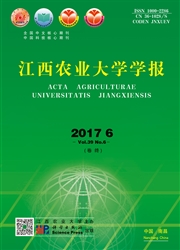

 中文摘要:
中文摘要:
为了探讨大豆品种耐盐性的抗性机理,应用蛋白质组学技术,对耐盐大豆品种Lee68和盐敏感大豆品种N2899萌发期幼苗的蛋白质组成进行比较分析。用三氯乙酸/丙酮法提取大豆幼苗的蛋白质,双向电泳技术分离,考马斯亮蓝染色,在pH 4.0~7.0的2-DE胶上平均可检测到约650个的蛋白质点。比较Lee68和N2899幼苗的2-DE图谱,有52个差异表达蛋白点。选取6个蛋白质点,用MALDI-TOF-MS测定肽质量指纹图谱,搜索大豆UniGene库,成功鉴定出4个蛋白质,分别是GST 9、GST 10、种子成熟蛋白PM36和26 ku未知蛋白;并对这些蛋白质在耐盐性不同品种中可能作用进行讨论。
 英文摘要:
英文摘要:
To investigate the resistance mechanism of different soybean cultivars to salt tolerance the whole proteins of soybean seedlings from the salt-tolerant cultivar Lee68 and salt-sensitive cultivar N2899 were compared using proteomic analysis. Proteins were extracted using a trichloroacetic acid/acetone protocol, sep- arated by two-dimensional electrophoresis and stained with coomassie brilliant blue. On the pH 4 -7 2-DE gels there were about 650 protein spots, in which there were 52 differentially expressed spots in abundance be- tween the 2-DE maps of the Lee68 and N2899 soybean seedlings. Then 6 proteins were identified by MALDI- TOF-MS. The peptide mass fingerprint was searched against the soybean UniGene database and 4 proteins were successfully identified. They were GST 10, GST 9, seed maturation protein PM36 and hypothetical 26.0 ku protein. A possible role of these proteins was discussed between different salt-tolerant cuhivars.
 同期刊论文项目
同期刊论文项目
 同项目期刊论文
同项目期刊论文
 期刊信息
期刊信息
